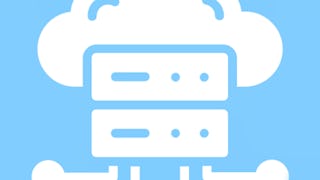Infrastructure as a Service (IaaS) allows users to provision processing, storage, networks, and other fundamental computing resources which then allows them to deploy and run arbitrary software, which can include operating systems and applications. Students will learn how to provision, deploy and manage operating systems, storage, and deployed applications as well as virtual networking components such as switches, routers, and firewalls in a cloud environment accessible remotely through a network.


Cloud: Infrastructure as a Service - Master's
This course is part of multiple programs.

Instructor: Thomas Johnson
Included with
Recommended experience
What you'll learn
Building a virtual machine in the cloud
Navigating pitfalls of migrating workloads to the cloud such as cost implications, and time required to migrate data
Creating a serverless application that runs in the cloud
Skills you'll gain
- Cost Management
- Business Continuity
- Cloud Infrastructure
- Cloud Computing
- Cloud Deployment
- Cloud Storage
- Cloud-Native Computing
- Cloud Security
- Virtualization
- Infrastructure As A Service (IaaS)
- Virtual Networking
- Cloud Management
- Continuous Integration
- Cloud Applications
- DevOps
- Amazon Web Services
- Serverless Computing
- Disaster Recovery
Details to know

Add to your LinkedIn profile
33 assignments
See how employees at top companies are mastering in-demand skills

Build your subject-matter expertise
- Learn new concepts from industry experts
- Gain a foundational understanding of a subject or tool
- Develop job-relevant skills with hands-on projects
- Earn a shareable career certificate

There are 9 modules in this course
Welcome to Cloud: Infrastructure as a Service! This module is the beginning of the journey into Infrastructure as a Service (IaaS) and starts by exploring terminology used in cloud computing, the key components of IaaS and a high-level overview of the top three providers offerings.
What's included
11 videos5 readings4 assignments1 discussion prompt
There are three key concepts in cloud computing – Virtualization/Compute, Networking, and Storage. We take some time to dig deeper into each of these concepts and discuss the relationship of each to the cloud computing model.
What's included
10 videos4 readings4 assignments
Cloud computing is a game changer in terms of speed, automation, and efficiency when it comes to developing software. We will cover concepts that are only available in the cloud computing model and discuss why these concepts are a core component of modern software development.
What's included
8 videos5 readings4 assignments
Migrating workloads to the cloud take planning and there will likely be infrastructure that continues to exist in the enterprise. This module explores how to plan for a cloud migration, as well as a discussion about pricing models – using AWS as a sample model.
What's included
10 videos4 readings4 assignments
The key to a successful cloud computing implementation is the ability to manage and monitor cloud resources. We explore a few key resources to accomplish this along with a discussion of the importance of monitoring.
What's included
8 videos4 readings4 assignments
Security is a complex subject, and is a conversation that happens throughout the cloud computing model. We explore the threats to cloud computing along with an overview of the various products that help protect cloud computing resources. We take a look at a concept called “the Shared Responsibility Model” which is platform agnostic, but we review the model as described by AWS.
What's included
10 videos4 readings4 assignments
There are many inherent components of resiliency built into cloud computing, but understanding their nuance and knowing how to leverage them are key to the development of a solid business contingency plan. We look at a case study and various solutions provided by AWS.
What's included
9 videos4 readings4 assignments
Building out capability in the cloud requires a shift in thinking. This shift comes in the form of understanding how cloud native applications work and can be leveraged. We look at some real world examples of how large businesses are leveraging IaaS to deliver services to their customers.
What's included
5 videos4 readings4 assignments
This module contains the summative course assessment that has been designed to evaluate your understanding of the course material and assess your ability to apply the knowledge you have acquired throughout the course.
What's included
1 assignment
Earn a career certificate
Add this credential to your LinkedIn profile, resume, or CV. Share it on social media and in your performance review.
Build toward a degree
This course is part of the following degree program(s) offered by Illinois Tech. If you are admitted and enroll, your completed coursework may count toward your degree learning and your progress can transfer with you.¹
Instructor

Offered by
Explore more from Cloud Computing
 Status: Preview
Status: PreviewIllinois Tech
 Status: Free Trial
Status: Free TrialIllinois Tech
 Status: Free Trial
Status: Free Trial Status: Preview
Status: PreviewIllinois Tech
Why people choose Coursera for their career





Open new doors with Coursera Plus
Unlimited access to 10,000+ world-class courses, hands-on projects, and job-ready certificate programs - all included in your subscription
Advance your career with an online degree
Earn a degree from world-class universities - 100% online
Join over 3,400 global companies that choose Coursera for Business
Upskill your employees to excel in the digital economy
Frequently asked questions
To access the course materials, assignments and to earn a Certificate, you will need to purchase the Certificate experience when you enroll in a course. You can try a Free Trial instead, or apply for Financial Aid. The course may offer 'Full Course, No Certificate' instead. This option lets you see all course materials, submit required assessments, and get a final grade. This also means that you will not be able to purchase a Certificate experience.
When you enroll in the course, you get access to all of the courses in the Specialization, and you earn a certificate when you complete the work. Your electronic Certificate will be added to your Accomplishments page - from there, you can print your Certificate or add it to your LinkedIn profile.
Yes. In select learning programs, you can apply for financial aid or a scholarship if you can’t afford the enrollment fee. If fin aid or scholarship is available for your learning program selection, you’ll find a link to apply on the description page.
More questions
Financial aid available,

